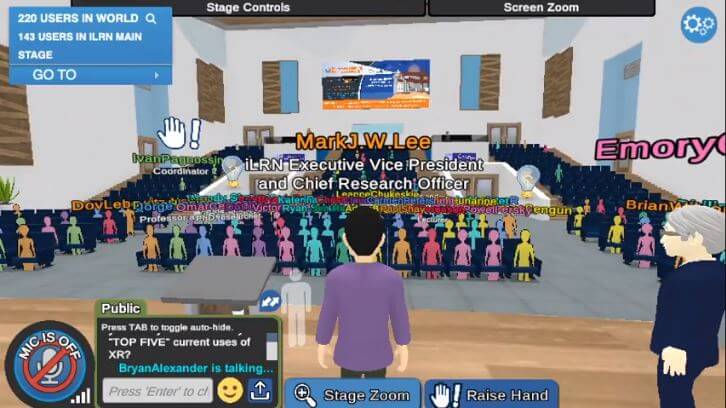The Immersive Learning Research Network International Virtual Conference concluded last Thursday. What would have been an in-person event was instead held in the VR collaboration platform VirBELA, and through live streams on iLRN’s Youtube channel.
The conference featured dozens of talks, panel discussions, social events, and other sessions over the five-day event. These included a number of new events, including that inaugural “State of XR and Immersive Learning Outlook Report,” research symposiums, and a “game jam series” in which participants tried to use XR to address social and environmental issues.
Here, we’ve pulled together some of our highlights.
Immersive Learning
“I think that many of you are here because we’re moving to a point where we can be creators as well as consumers. It’s great to have someone else make an immersive experience for us but when the medium really takes off is when people can make it their own and share their own thoughts and feelings,” Professor and “Grandfather of iLRN”, Chris Dede, said in the Welcome address.
The theme of the conference was immersive experiences in education. That meant both trends in how these experiences are created and used, and discussions of how this use and creation should be developed.
How XR Can Help Provide Resilience
“One of the things that I think [immersive technology] really does is it democratizes education. And it democratizes learning so much, so that people are not as restricted in what it is that they are capable of learning,” JMXR founder and CEO, Jeff Meador, said in “How XR Can Help Provide Resilience and Continuity to Education and Training Operations During a Global Crisis.” “They are not restricted by geography. They are not restricted by income as much.”
In the same panel discussion, Sketchbox founder Joe Conolly said that the move to immersive learning was an extension of online learning through platforms like Coursera.
VR as a Force of Change
While this may be the case, Professor Carolina Cruz-Neira, best known for creating the CAVE, said that immersive technology, as we tend to think of it, is not yet ready for mass adoption in immersive learning.
“At this moment, today, 2020, headset technology does not really address seriously the needs of social interaction and teamwork that is needed to learn,” Cruz-Neira said in her keynote “VR as a Force of Change in Education.”
While that may seem like a grim outlook, Cruz-Neira also expressed optimism in the future of non-headset-based immersive experiences.
“It’s kind of like how, in the middle ages, everybody used horses and carts as transportation but today we use many other ways of transportation,” Cruz-Neira said. “In my opinion, right now, we are in the horses-and-carts stage of VR and AR history.”
Announcements and Launches
The horses-and-carts stage of immersive experiences looks pretty exciting from where we are. The conference featured two significant launches for immersive experiences.
Groundbreaking immersive journalist Nonny de la Peña held a live launch of the Reach VR platform. The Sketchfab-based creator tool made in Bootstrap allows users to draw from asset libraries to make 3D experiences that work with headsets or in-browser.

Also launched at the conference was the State of XR in Immersive Learning Outlook Report. Compiled by a panel of XR technology experts over a year, the report examined the advantages and drawbacks of XR in immersive learning.
The main obstacles included a lack of tech support, a shortage of quality educational immersive content, and access issues related to start-up cost. Key advantages included developments in artificial intelligence, haptics, content accessibility, and volumetric capture technology.
“XR doesn’t stand alone as a technology,” Digital Bodies cofounder and CEO, Emory Craig, said. “We’re going to see XR converge with AI developments, and it’s going to lead to amazing opportunities.”
Finding More Immersive Learning Content
The iLRN conference is over, and we couldn’t cover all of it. Unfortunately, right now, recordings of the content are only available for people who registered for the conference.
The good news is that for a deep dive on everything in the world of immersive learning you can check out the iLRN website. There you can find proceedings, the State of Immersive Learning report, and more.




